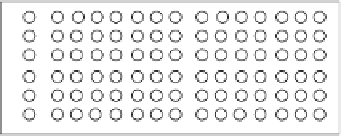Biology Reference
In-Depth Information
and colloquially called ''reverse transcriptase.''
2
This method takes
advantage of the poly(A) tail on the RNA by using oligo(dT) molecules
as primers to begin the reverse transcription process. The reverse
transcriptase enzyme incorporates the correct deoxyribonucleotide
building blocks into the growing chain, making a DNA copy of the
mRNA (note that the DNA uses T nucleotides instead of the U
nucleotides of the mRNA molecule).
Next, the cDNA needs to be labeled to allow us to distinguish between
normal and cancer cell cDNAs. Two different techniques can be used
to accomplish this: direct enzymatic incorporation and chemical coupling.
In direct enzymatic labeling, the most common technique, a
fluorescently labeled nucleotide is introduced into the cDNA as it is
being made. When two different kinds of cell mRNAs are used,
fluorescent dyes are used with one emission wavelength for the normal
cell cDNA and another emission wavelength for the cancer cell cDNA.
Two commonly used dyes are Cy3 and Cy5, which emit green and red
light, respectively. This method allows the simultaneous use of both
cDNAs to probe a single microarray. In chemical coupling, a modified
nucleotide is introduced during cDNA synthesis. This modified
nucleotide is then labeled through a second step, a chemical reaction
with the fluorescent dye.
B. Making the Microarray
Microarrays are collections of thousands of different kinds of DNA
attached to a solid substrate. The substrate may be a glass or plastic slide
or a nylon membrane. Microarrays are made by one of two processes,
known as mechanical spotting and photolithography (described below).
A diagram of a spotted microarray is shown in Figure 12-4. In this figure,
each of the circles on the array represents a tiny drop of DNA solution,
by which the DNA is delivered and then chemically attached to the
slide. Microarrays produced by the mechanical spotting method may
bear either cDNAs or oligonucleotides.
3
Microarrays produced by
photolithography bear only oligonucleotides. In either case, each tiny
area bearing a set of DNA molecules is called a spot or feature.
FIGURE 12-4.
Graphic representation of a spotted microarray.
Each spot or feature contains cDNA or
oligonucleotides.
In mechanical spotting, DNA is made first and then placed on the slide.
If the microarray is to contain cDNAs, the cDNA of interest can be
made through cloning or through the polymerase chain reaction (PCR).
2. Reverse transcriptases are isolated from retroviruses, which have an RNA
genome. The life cycle of the retrovirus includes the production of a DNA copy
of their RNA genome using reverse transcriptase and then the integration of the
DNA copy into the host cell's own DNA.
3. Oligonucleotides are relatively short polymers made of several nucleotides.
Sequences can be selected or built to represent specific genes of interest, as
described in the next section.











